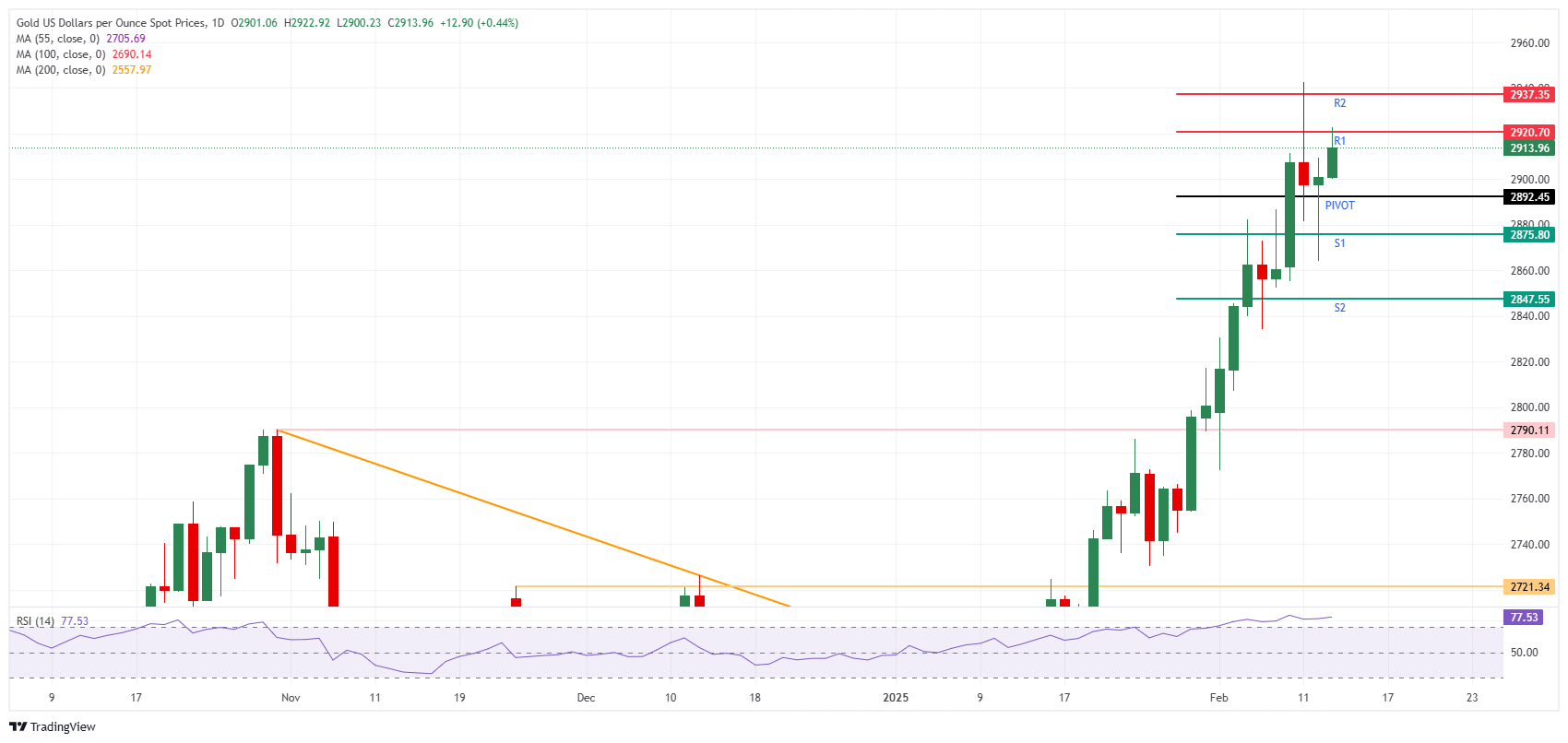Gold picks up ascent despite risks residing in the background

- Gold is on the forefront again and resumes its rally mode.
- Headwinds remain with a possible peace deal for Ukraine and US inflation concerns.
- Gold is back on its way to test the all-time high at $2,942.
Gold’s price (XAU/USD) soars again and resumes its rally near $2,920 at the time of writing on Thursday, with Bullion traders shrugging off the United States (US) Consumer Price Index (CPI) data for January released on Wednesday. Traders are also ignoring the possibility of a peace deal formation with United States (US) President Donald Trump and Russian President Vladimir Putin, who have spoken on the phone to outline a meeting soon to work out the broad strokes of a peace deal. Despite these quite substantial tail risks, Gold is rallying again, revealing a firm commitment from traders to keep residing in the safe haven asset.
Meanwhile, traders are digesting Federal Reserve (Fed) Chairman Jerome Powell’s two testimonies at Capitol Hill before lawmakers. The release of January’s Consumer Price Index (CPI) numbers on Wednesday proved that the Fed has the right angle to keep rates steady for longer. US yields surged during the past two days, though with the pickup in Gold buying, the question will be whether US yields can keep rising in tandem with an uptick in Gold, which is a bit contradictory.
Daily digest market movers: Geopolitics take over
- US President Donald Trump said that Hamas must release all hostages by noon on Saturday or ‘all hell will break loose’, Reuters reports.
- Ukraine talks are spurring risk assets and the Euro (EUR) against the US Dollar (USD). This, in turn, triggers a softer US Dollar Index (DXY), which gauges the Greenback’s value against six major currencies, which is beneficial for Gold.
- After the hotter-than-expected January CPI reading, the CME FedWatch tool shows a 64.3% chance that interest rates will remain unchanged at current levels in June, compared to 50.3% before the release. This suggests that the Fed would keep rates unchanged for longer to fight against persistent inflation.
Technical Analysis: Buy the dip, but…
Gold traders have used January’s CPI release as an entry point to buy more stakes in their beloved precious metal. However, a considerable tail risk could deliver quite a harsh and quick correction in Gold: the Ukraine peace talks. Once those peace talks start to take shape and might get support from Ukraine and Europe, a risk-on wave in markets would occur, with safe-haven outflows and Gold being punished.
The first support level on Thursday is $2,892, which is the Daily Pivot. From there, S1 support should come in at $2,875. The S2 support at $2,847 should act as a safeguard and avoid any further declines to the bigger $2,790 level (October 31, 2024, high).
On the upside, the R1 resistance at $2,920 is the first level that needs to be recovered, followed by the R2 resistance at $2,937. In case the rally continues, the $2,950 big figure will be tested for a break to the upside. Further up, the $3,000 psychological level could be next.
XAU/USD: Daily Chart
Gold FAQs
Gold has played a key role in human’s history as it has been widely used as a store of value and medium of exchange. Currently, apart from its shine and usage for jewelry, the precious metal is widely seen as a safe-haven asset, meaning that it is considered a good investment during turbulent times. Gold is also widely seen as a hedge against inflation and against depreciating currencies as it doesn’t rely on any specific issuer or government.
Central banks are the biggest Gold holders. In their aim to support their currencies in turbulent times, central banks tend to diversify their reserves and buy Gold to improve the perceived strength of the economy and the currency. High Gold reserves can be a source of trust for a country’s solvency. Central banks added 1,136 tonnes of Gold worth around $70 billion to their reserves in 2022, according to data from the World Gold Council. This is the highest yearly purchase since records began. Central banks from emerging economies such as China, India and Turkey are quickly increasing their Gold reserves.
Gold has an inverse correlation with the US Dollar and US Treasuries, which are both major reserve and safe-haven assets. When the Dollar depreciates, Gold tends to rise, enabling investors and central banks to diversify their assets in turbulent times. Gold is also inversely correlated with risk assets. A rally in the stock market tends to weaken Gold price, while sell-offs in riskier markets tend to favor the precious metal.
The price can move due to a wide range of factors. Geopolitical instability or fears of a deep recession can quickly make Gold price escalate due to its safe-haven status. As a yield-less asset, Gold tends to rise with lower interest rates, while higher cost of money usually weighs down on the yellow metal. Still, most moves depend on how the US Dollar (USD) behaves as the asset is priced in dollars (XAU/USD). A strong Dollar tends to keep the price of Gold controlled, whereas a weaker Dollar is likely to push Gold prices up.
Information on these pages contains forward-looking statements that involve risks and uncertainties. Markets and instruments profiled on this page are for informational purposes only and should not in any way come across as a recommendation to buy or sell in these assets. You should do your own thorough research before making any investment decisions. FXStreet does not in any way guarantee that this information is free from mistakes, errors, or material misstatements. It also does not guarantee that this information is of a timely nature. Investing in Open Markets involves a great deal of risk, including the loss of all or a portion of your investment, as well as emotional distress. All risks, losses and costs associated with investing, including total loss of principal, are your responsibility. The views and opinions expressed in this article are those of the authors and do not necessarily reflect the official policy or position of FXStreet nor its advertisers. The author will not be held responsible for information that is found at the end of links posted on this page.
If not otherwise explicitly mentioned in the body of the article, at the time of writing, the author has no position in any stock mentioned in this article and no business relationship with any company mentioned. The author has not received compensation for writing this article, other than from FXStreet.
FXStreet and the author do not provide personalized recommendations. The author makes no representations as to the accuracy, completeness, or suitability of this information. FXStreet and the author will not be liable for any errors, omissions or any losses, injuries or damages arising from this information and its display or use. Errors and omissions excepted.
The author and FXStreet are not registered investment advisors and nothing in this article is intended to be investment advice.




